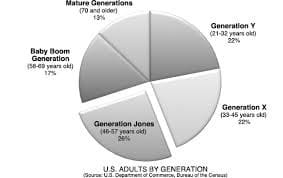Keeping Up with the Jones Generation: Medical Marketing Demographic Sweet Spot

Kathy Gaughran,
Sr. Marketing Strategist
[Series Installment] Our recent post in this series declared the “Gen-Y” population group to be the “biggest ever” slice of the population. It turns out that “biggest” depends on who’s doing the slicing. Take a look at the Jones crowd.
Medical marketing professionals need to keep up with the Jones Generation cohort, a “sweet spot” carve-out between “Boomers” and “Gen X-ers,” roughly 46-57 years old (or 35-47 by some demographers), and representing about a quarter of the US adult population.
Los Angeles pop-culture author Jonathan Pontell felt that people born between 1954 and 1965 were statistically important, but under-represented, and tagged them with the Generation Jones (or Jonsers) label. It carries the slang connotation of competitiveness as in “keeping up with the Joneses,” according to Wikipedia, and “jones” or “jonesing,” for yearning or craving.
Characteristics of Gen-Jones demo…
The marketing significance is partly vested in the group’s size: about 53 million, with a spending power that approaches $1.5 trillion, often with more disposable income than others.. And by most definitions, Gen-Jones people “need, want and take everything all the time.” Their typical mindset is “WIIFM…what’s in it for me?”
- Health and wellness is important, including exercise, healthy diet and staying fit;
- “Looking good” extends to elective and cosmetic products and medical procedures;
- Oriented to hard work, career advancement and earning money;
- Personal convenience—such as fast food service and multi-tasking—appeals to them;
- Conspicuous consumption includes big purchases often on credit;
- Media- and tech-savvy, about one-third of Internet users are in this cohort; and
- Often among Early Adopters with technology, online advances and new tech-toys.
Properly crafting an effective message for Generation Jones requires connecting with their need for immediate gratification and their preference for instant communications. Thus the use of succinct and to-the-point advertising via Internet marketing platforms. They are open to switching brands or providers, particularly when the message offers a promise of “living the good life.”
For more in this series and generational planning read, Meet the Millennials, and our previous post, No Boomer Left Behind in Healthcare Marketing Plans.
Senior Marketing Strategist Kathy Roy Gaughran









